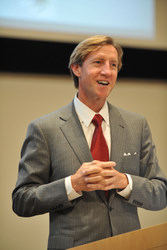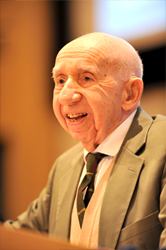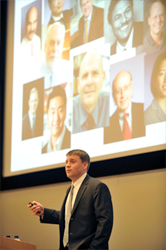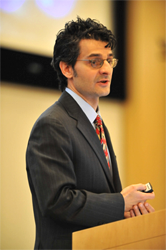Sesquicentennial Finale Reflects on 150 Years of Progress, Looks Forward to Future of Medicine
 |
| J. Larry Jameson, MD, PhD, vice president for medical affairs and Lewis Landsberg Dean of the Feinberg School of Medicine. |
 |
| Jeremiah Stamler, MD, professor emeritus and the first chair of the Department of Preventive Medicine. |
 |
| C. Shad Thaxton, MD, PhD, assistant professor in the Department of Urology. |
 |
| Reed Omary, MD, professor in the Department of Radiology. |
The Feinberg School of Medicine ended its yearlong sesquicentennial celebration with a finale event, “Ties to the Past, Eyes to the Future,” which included a series of expert presentations that provided the Feinberg community with an opportunity to reflect on the transformation of both the City of Chicago and of medicine over the past 150 years. The medical school also looked ahead to the next 150 years of advancements by exploring the cutting edge research happening at Northwestern.
J. Larry Jameson, MD, PhD, vice president for medical affairs and Lewis Landsberg Dean of the Feinberg School of Medicine, took a glimpse back at the rich history of the medical school before looking to the future, highlighting the recent assessment of the Feinberg curriculum and modifications that will allow for more flexibility in the training of medical students.
“Northwestern has always prided itself on having an innovative curriculum,” Jameson said. “It was really the founders of the medical school that set the stage.”
Jameson was followed by three speakers, each of whom provided a retrospective on events that have had an impact on Feinberg. Henry Binford, PhD, associate professor in the Weinberg College of Arts and Sciences Department of History, explored the vast changes the City of Chicago has experienced over the past 150 years, whereas Stephen Greenberg, MSLS, PhD, from the History of Medicine Division of the National Library of Medicine, discussed the advances in medicine. Jeremiah Stamler, MD, professor emeritus and the first chair of the Department of Preventive Medicine, shared his experiences at Northwestern and his work throughout the years conducting clinical trials related to arterial disease.
“I came to Chicago to pursue atherosclerosis research,” Stamler said. “When I showed up for my first day of work in 1948, I thought I knew all about everything; but there was a lot I needed to learn.”
In his retrospective, Stamler also emphasized the importance of living mentors — naming several teachers that were particularly influential in shaping his career —and recognized the strides that have been made in coronary artery disease prevention.
The series of faculty presentations that followed explored the medical innovations in progress at Northwestern and around the world. John A. Kessler, MD, Ken and Ruth Davee Professor of Stem Cell Biology in the Department of Biology, discussed breakthroughs in regenerative medicine, while Nathaniel J. Soper, MD, professor and chair of the Department of Surgery, focused on the improvements being made in minimally invasive surgery and the movement toward noninvasive surgical treatments. Todd A. Kuiken, MD, PhD, professor in the Department of Physical Medicine and Rehabilitation, demonstrated the advancements in rehabilitation by reviewing the medical history of one patient and the use of targeted reinnervation to permit sensory movement with prosthetic arms.
Once a student at Feinberg, C. Shad Thaxton, MD, PhD, is now an assistant professor in the Department of Urology and an expert in bio-nanotechnology.
“Northwestern has a rich history in nanotechnology,” Thaxton said. “By collaborating across disciplines, researchers from both our Chicago and Evanston campuses are pacing the advancements in this field.”
Another faculty member, Reed Omary, MD, professor in the Department of Radiology, emphasized the benefits of nanotechnology in image-guided interventions before sharing several of his predictions for the future of imaging.
“Instead of treating all patients the same, there will be an emergence of customized therapies,” Omary said. “At Northwestern, we already have combined MRI and radiology suites, so we can monitor procedures as they’re happening and provide physicians with immediate feedback.”
Dean Jameson closed the event by applauding the amazing work being done at Northwestern and reminding the audience of the unpredictability that the next 150 years of scientific innovations hold.
“At the Feinberg School of Medicine, we want to perform research that has an impact … research that stimulates ideas in other people,” Jameson said.
Jameson continued to explain that Northwestern Medicine, a joint vision with Northwestern Memorial Hospital, has an explicit strategy of connecting people from multiple disciplines to achieve an environment that fosters collaboration in research.
“At Northwestern, there are so many resources for investigators to tap into, like the Kellogg School of Management and the Robert R. McCormick School of Engineering and Applied Science,” Jameson said. “By moving forward with the Northwestern Medicine initiative, we plan to attract the most talented students and faculty and create The Great Academic Medical Center.”






